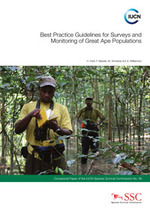Surveys and Monitoring of Great Ape Populations
 The guidelines for surveys and monitoring of great ape populations address the challenge of collecting consistently high-quality data for comparison between sites and across years. The need for standardisation is driven less by academic interest than by the urgent demands of field-based conservation. The maelstrom of threats which now endanger all the great apes must be addressed by immediate action on every scale: initiatives at individual sites, strategies on the regional and national level, and species-wide action plans and international accords. All of these efforts must be founded on accurate field data. To fully understand the impact of specific threats, and to measure conservation success, it is essential to have baseline density estimates and sustained monitoring of great ape populations.
The guidelines for surveys and monitoring of great ape populations address the challenge of collecting consistently high-quality data for comparison between sites and across years. The need for standardisation is driven less by academic interest than by the urgent demands of field-based conservation. The maelstrom of threats which now endanger all the great apes must be addressed by immediate action on every scale: initiatives at individual sites, strategies on the regional and national level, and species-wide action plans and international accords. All of these efforts must be founded on accurate field data. To fully understand the impact of specific threats, and to measure conservation success, it is essential to have baseline density estimates and sustained monitoring of great ape populations.
This publication outlines current approaches to these issues, offering guidance and perspective on choices that must be made by wildlife biologists, site managers, government agencies and the conservation community at large. This report provides an overview of the variety of survey methodologies that have been developed, as well as a decision tree to help select the approach that is best for a particular site or situation, depending on available resources. As a continuation of this report, a series of modules are available online (see below).
These guidelines complement the goal of the IUCN SSC A.P.E.S. database https://www.iucngreatapes.org/apes-database, which serves as a repository for survey data on great apes. The guidelines, combined with resources available via the A.P.E.S. Portal, are an important step towards a comprehensive understanding of the conservation status of great apes, at both the population and species level.
Chapters 1 & 2 are available below:
English: Best Practice Guidelines for Surveys and Monitoring of Great Ape Populations
Citation: Kühl, H., Maisels, F., Ancrenaz, M. & Williamson, E.A. (2008). Best Practice Guidelines for Surveys and Monitoring of Great Ape Populations. IUCN SSC Primate Specialist Group, Gland, Switzerland.
Citation: Kühl, H., Maisels, F., Ancrenaz, M. et Williamson, E.A. (2009). Lignes directrices pour de meilleures pratiques en matière d’inventaire et de suivi des populations de grands singes. Groupe de specialists des primates de la CSE UICN, Gland, Suisse
Bahasa Indonesia: Panduan Survei dan Pemantauan Populasi Kera Besar
Citation: Kühl, H., Maisels, F., Ancrenaz, M. dan Williamson, E.A. (2011). Panduan Survei dan Pemantauan Populasi Kera Besar. IUCN SSC Primate Specialist Group, Gland, Switzerland.
Bahasa Malaysia: Panduan Amalan Terbiak Survei dan Pemantauan Populasi Kera Besar
Citation: Kühl, H., Maisels, F., Ancrenaz, M. dan Williamson, E.A. (2010). Panduan Amalan Terbaik Survei dan Pemantauan. Populasi Kera Besar. IUCN SSC Primate Specialist Group, Gland, Switzerland.
To request a paper copy of these guidelines, please contact Jill Lucena at jlucena@rewild.org
A series of draft modules are also available:
- Chapter 3: Survey design (English) Survey design (French)
- Chapter 5: Field Issues: logistics and survey data collection protocols
- Chapter 5: Conducting interviews in the field
- Chapter 6: Training for surveys
- Chapter 8: Standard report template
These modules present detailed information on survey design, field techniques, analytical approaches, and practical issues such as logistics and standardized reporting.
Additional resources:
White, L. & Edwards, A. eds. 2000. Conservation Research in the African Rain Forests: A Technical Handbook. Wildlife Conservation Society, New York. 444 PDF
En francais: White, L. & Edwards, A. eds. 2000. Conservation des forêts pluviales Africaines: manuel des méthodes de recherche PDF
The Primate Specialist Group gratefully acknowledges financial support from the Arcus Foundation and the United State Fish and Wildlife Service for the production and publication of these guidelines.




